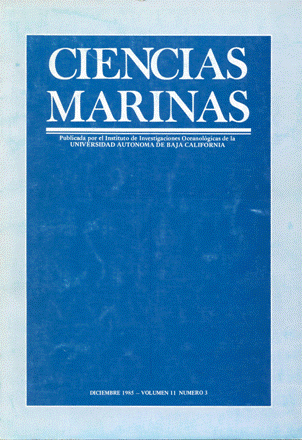Analysis of the benthic infauna from Bahia de San Quintin, Baja California, with emphasis on its use in impact assessment studies
Main Article Content
Abstract
An ecological analysis of benthic polychaete assemblages is presented. Samples were collected at ll stations in July, September and December 1981, and February and May 1982. Thirty-nine species in 21 families of polychaetes were identified. Spatial variations may be due to microhabitats and/or the intrinsic biology of the species. The abundance increased in spring because of reproduction and recruitment. The values of the Shannon diversity index were as high as 3.1 and 0.9 for evenness. Clusters among stations could not be identified which may have been because of the dominance of five species (Exogone occidentalis, Pseudopolydora kempi, Scoloplos acmeceps, Prionospio heterobranchia and Neanthes arenaceodentata) and the relative abundance of secondary species. The abundance, number of species and evenness were not significant (p > > 0.05) when correlated with the content of organic matter and sediment particle size. The log-normal distributions of individuals among species did not detect pollution-induced changes in the community. The benthic community in Bahía de San Quintín was found to be at or near equilibrium which may be the result of a relatively high resilience to disturbance. A qualitative assessment of the possible impact of domestic sewage on the infauna and an outline for the ecological management of the bay are presented.
Downloads
Article Details
This is an open access article distributed under a Creative Commons Attribution 4.0 License, which allows you to share and adapt the work, as long as you give appropriate credit to the original author(s) and the source, provide a link to the Creative Commons license, and indicate if changes were made. Figures, tables and other elements in the article are included in the article’s CC BY 4.0 license, unless otherwise indicated. The journal title is protected by copyrights and not subject to this license. Full license deed can be viewed here.

